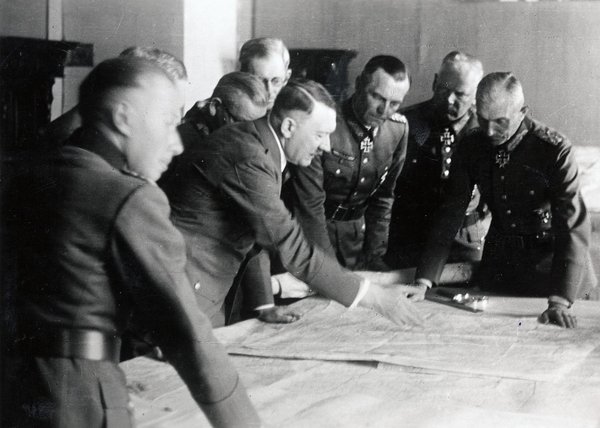Lección
Introduction to World War II's Beginnings
World War II was a global conflict that engulfed much of the world from 1939 to 1945. But understanding its origins requires us to look back to the aftermath of World War I and the simmering tensions that followed. This lesson explores the conditions in Europe and Asia after WWI that directly led to the outbreak of WWII. Remember, if you ever feel lost or need clarification, don't hesitate to ask the AI Tutor for help. It has a vast understanding of this history and can offer valuable perspectives.
The Treaty of Versailles: A Seed of Resentment
The Treaty of Versailles, signed in 1919, officially ended World War I. However, its harsh terms imposed on Germany created deep resentment and instability. Germany was forced to accept full responsibility for the war, disarm its military, and pay heavy reparations.
Territorial Losses and National Humiliation
Germany also lost significant territory, including Alsace-Lorraine, which was returned to France, and parts of eastern Germany that were ceded to Poland. These territorial losses and the overall humiliation fostered a sense of injustice and a desire for revenge among many Germans.
Economic Hardship in Germany
The enormous reparations burden crippled the German economy, leading to hyperinflation and widespread poverty. This economic hardship created fertile ground for extremist ideologies that promised to restore Germany's former glory.
The Rise of Fascism and Militarism
Fascism, an authoritarian political ideology, gained popularity in Italy under Benito Mussolini and later in Germany under Adolf Hitler. Fascist regimes emphasized nationalism, militarism, and the suppression of dissent.
Militarism and Expansionism
Both Italy and Germany pursued aggressive foreign policies, seeking to expand their territories and influence. This militaristic expansionism directly challenged the existing international order and heightened tensions.
Hitler's Rise to Power
Adolf Hitler, leader of the Nazi Party, rose to power in Germany in 1933. He quickly consolidated his control, dismantled democratic institutions, and began to rearm Germany in violation of the Treaty of Versailles.

Appeasement and Its Consequences
In the face of Hitler's aggression, Britain and France adopted a policy of appeasement, hoping to avoid war by conceding to some of his demands. However, this policy only emboldened Hitler and allowed Germany to grow stronger.
The Munich Agreement
A prime example of appeasement was the Munich Agreement of 1938, in which Britain and France allowed Germany to annex the Sudetenland region of Czechoslovakia. This agreement is now widely viewed as a major miscalculation that hastened the outbreak of war.
The Invasion of Poland: The Spark
The final trigger for World War II was Germany's invasion of Poland on September 1, 1939. Britain and France, having pledged to defend Poland, declared war on Germany, marking the beginning of the global conflict.
Japanese Expansionism in Asia
While Europe teetered on the brink of war, Japan pursued its own expansionist ambitions in Asia. Japan sought to create a "Greater East Asia Co-Prosperity Sphere," which would establish its dominance over the region.
The Invasion of Manchuria
In 1931, Japan invaded Manchuria, a region in northeastern China, and established a puppet state. This act of aggression was condemned by the League of Nations but was met with little concrete action.
The Second Sino-Japanese War
In 1937, Japan launched a full-scale invasion of China, beginning the Second Sino-Japanese War. This conflict further destabilized Asia and contributed to the growing global tensions. Remember, the AI Tutor can help you draw parallels between the events in Europe and Asia.
The Axis Powers
Germany, Italy, and Japan formed an alliance known as the Axis Powers. This alliance solidified their common goals of expansionism and aggression and set the stage for a global conflict.
The Failure of the League of Nations
The League of Nations, established after World War I to maintain peace, proved ineffective in preventing the rise of aggression and the outbreak of World War II. Its weakness and inability to enforce its decisions contributed to the escalating crisis.
Table: Key Factors Leading to WWII
Here's a summary of the key factors that contributed to the outbreak of World War II:
| Factor | Description |
|---|---|
| Treaty of Versailles | Harsh terms imposed on Germany fostered resentment and instability. |
| Economic Hardship | Hyperinflation and poverty in Germany fueled extremist ideologies. |
| Rise of Fascism | Authoritarian regimes in Italy and Germany pursued aggressive foreign policies. |
| Appeasement | Britain and France's policy of appeasement emboldened Hitler. |
| Japanese Expansionism | Japan's aggression in Asia further destabilized the global situation. |
| Failure of League of Nations | The League's weakness failed to prevent aggression. |
Conclusion
The seeds of World War II were sown in the aftermath of World War I. The Treaty of Versailles, the rise of fascism and militarism, the policy of appeasement, and Japanese expansionism all contributed to the escalating tensions that ultimately led to the outbreak of the global conflict. This complex interplay of factors serves as a crucial reminder of the importance of diplomacy, international cooperation, and vigilance against aggression.












